Today, April 12th —
I had a carpenter come in to do some repair work around the house. I asked him to remove the carpet from the steps leading from the hallway to the kitchen and living room area. He gave me a blank stare.
Mon 12 Apr 2021
Today, April 12th —
I had a carpenter come in to do some repair work around the house. I asked him to remove the carpet from the steps leading from the hallway to the kitchen and living room area. He gave me a blank stare.
Sat 10 Apr 2021
â— WEDDING PRESENT. Paramount Pictures, 1936. Cary Grant, Joan Bennett, George Bancroft, Conrad Nagel, William Demarest, Gene Lockhart, Edward Brophy. Screenplay: Joseph Anthony, based on a story by Paul Gallico. Directed by Richard Wallace.
◠BIG BROWN EYES. Paramount Pictures, 1936. Cary Grant, Joan Bennett, Walter Pidgeon, Lloyd Nolan, Alan Baxter, Marjorie Gateson, Isabel Jewel, Douglas Fowley, Henry Brandon, Joe Sawyer. Screenplay by Raoul Walsh, Bert Hanlon, based on the stories “Big Brown Eyes†and “Hahsit Babe†by James Edward Grant. Directed by Raoul Walsh.
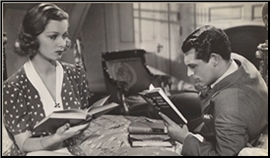
These two early Cary Grant starring vehicles are both bright genre films mixing screwball comedy, crime, and adventure and both co-starring Joan Bennett still a blonde, just before dying her hair dark in Tay Garnett’s Trade Winds would change her career forever.
Wedding Present is a screwball comedy about Chicago reporters Charlie Mason and Monica “Rusty†Fleming who as the film opens are flirting with marriage, but cold feet on both their parts as well as an addiction to elaborate practical jokes are the bane of their long suffering City Editor George Bancroft, who would fire them if they weren’t such good reporters.
Which they prove in short order by angling an interview with a visiting Archduke (Gene Lockhart), taking him on a monumental toot where they end up at the lake house of aviator George Meeker. Not only do they get an exclusive interview with the Archduke, they rescue New York gangster Smiley Benson from drowning earning his eternal gratitude, and learning a ship is lost in a storm on the lake hijack Meeker and his plane managing to find the missing ship and get a double headline before the noon edition.

When Bancroft can no longer put up with either of them he retires and Grant finds himself promoted to City Editor which infuriates Bennett when she comes back from a vacation. She heads off to New York where she meets obnoxiously obvious self-help author Roger Dodacker (Conrad Nagel) and gets engaged to him so Grant quits and heads to New York to win her back with the help of Smiley and a bit of kidnapping, false fire alarms, and a renewed sense of insanity.
Appropriately the films ends as they are carried away on top of a firetruck headed for Hillview Sanitarium.
It’s almost, but not quite a prequel to His Girl Friday as you can easily see Charlie and Rusty maturing to become Walter and Hildy.
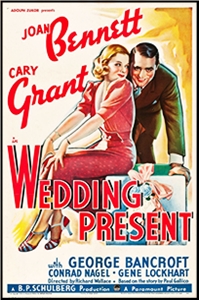
Crime is central rather than incidental to Big Brown Eyes.
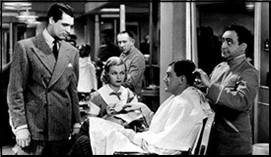
In this one Bennett is Eve Fallon, a manicurist who becomes a hot shot reporter and teams with her cop boyfriend Danny Barr (Grant) to solve the murder of a child after their bickering gets her fired from her job as a manicurist.
Walter Pidgeon is Richard Morey a slick lawyer who gets Lloyd Nolan’s gangster Russ Cortig off when a stray shot results in the death of a woman’s baby (Marjorie Gateson). The bickering Eve and Danny reunite when a disgusted Danny quits the force to get Nolan and crooked lawyer Pidgeon and the result is a fast moving, fast talking, surprisingly tough little film in a minor hard-boiled key — the kind of thing George Harmon Coxe, Dwight Babcock, and Richard Sale used to write — with Grant surprisingly good as a tough smart cop operating mostly like a private eye.
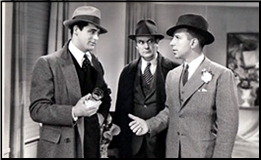
Raoul Walsh was one of the most capable action directors of all time and no mean hand at comedy, so this one moves hardly pausing for a breath as the action gallops by. Maybe it wouldn’t make the pages of Black Mask, but I can imagine it in Dime Detective or Detective Fiction Weekly.
The interest here is in seeing two major stars both on the cusp of breaking big in a pair of fast acting genre films and backed with first rate co-stars in the kind of thing the studios used to turn out seemingly effortlessly.
Wedding Present recently showed up streaming on Classic Reels and Big Brown Eyes can still be found on DVD from its 2014 release. Neither movie is a classic by any means, but both stars are well represented in these films that are fast, funny, and smart full of bright dialogue, wit, and movement.
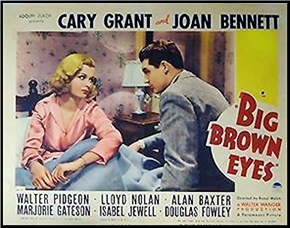
Fri 9 Apr 2021
DICK FRANCIS – Twice Shy. Putnam’s, hardcover, 1982. Fawcett Crest, paperback, 1983.
Over the years Dick Francis has become a very good writer. He’s always been an exceptional story-teller. Ever since he turned to writing mysteries, at the end of his career as a well-known steeple-chase jockey, his strength has been the inside knowledge he has of the world of championship racing, In one way or another, he’s displayed it to good advantage in every one of his books, all of them involving horses.

Studying and absorbing a collection of the complete Dick Francis, over twenty volumes at present count, would constitute a sure-fire education in picking and producing the next Derby winner, redeemable at any track in the United Kingdom. Thrown in at no extra charge would be a full blow-by-blow description of all the pitfalls the unwary horseman may encounter along the way.
Horses are in Dick Francis’ blood, and in that of every one of his heroes. It is also contagious. Even confirmed city-dwellers who have ridden a horse but once – like myself, or was it that the horse condescended to let me ride him? – or those who abominate all horsey stories from Black Beauty on up will find. themselves caught up in the excitement and the mystique and the thrill of the pounding final stretch. And that’s no mean accomplishment!
In Twice Shy we get two stories for the price of one. A pair of brothers, both innocent victims, find themselves threatened in turn by one of Francis’s patented and typically brutal villains – one in the first half, the other in the second.
Angelo Gilbert is certainly as bloodthirsty and despicably cruel an opponent as we’ve come to expect, but he’s also far less clever, and he proves much less of a challenge to be disposed of than that faced by most of Francis’s heroes. The fray is not without casualties – don’t be mistaken – but in spite of the tenseness of the various situations brothers Jonathan and William Derry unwittingly find themselves in, neither seems as overly taxed as they might have been.
At stake is a computerized betting system that, if it really existed, would be worth millions. For the most part, however, keep in mind that gambling is strictly a mugs’ game. William Derry’s book-making friend Taff is a fine example. Gambling is a way of life in which only the good mathematicians survive. As far as a successful system for betting on the horses is concerned, well, if anyone has one, and it works, it’s like the perfect crime – nobody’s telling anybody else about it.
From off-the-cuff handicapping, to the expertise of modern-day computer technology, Dick Francis’s name under the title of a book still means there’s plenty of excitement in store, from start to finish. This outing’s certainly no exception, but all in all I think Francis was coasting more than he usually does.
Rating: B plus.
Fri 9 Apr 2021
Never buy flowers from a monk. Only you can prevent florist friars.
Thu 8 Apr 2021

CHEYENNE “Mountain Fortress.†ABC / Warner Brothers, 60m, 20 September 1955 (Season One, Episode One). Clint Walker (Cheyenne Bodie), L. Q. Jones (Smitty Smith). Guest Cast: Ann Robinson, Bob Wilke, Peter Coe, James Garner, John Doucette. Director: Richard L. Bare. Season One has been released on DVD and is also currently streaming on Starz.
As I understand it, Cheyenne the TV series was a hit from the start, and it’s easy to see why. It’s an easy transition from the B-westerns that the TV audience in the mid-50s grew up with in the 1940s, complete with a hunky hero in the laconic Gregory Peck mode (Clint Walker), and a semi-goofy sidekick (L. Q. Jones), in the almost-but-not-quite Smiley Burnette et al. mode.

Add a story that wouldn’t be out of place in 1940s, except that it’s one that actually makes sense, plotwise, complete with a secondary cast of villains and cavalry men whose faces were well known in westerns before then, if not their names. (But do note one new face, that of James Garner as a cavalry lieutenant whose fiancée is on board a stagecoach ambushed by Indians. This may have been his first appearance in either movies or on TV.)

But as it turns out, the stagecoach was also the intended target of a gang of outlaws, who take both Cheyenne and Smitty prisoners, as well as the girl and the stage driver, and when the cavalry comes riding in, looking for the girl, they’re taken hostage too. All Cheyenne has to do to free the others is to guide the gang of outlaws safely to Mexico – through Indian territory, of course, and they’re already trapped on a high mountain top surrounded on all sides.

One quick observation, other than the fact, already pointed out, that this little more than a B-western, dressed up only a very very little, and that’s that the body count is very very high on both sides, and maybe that’s because (and this may be way off base) some of the footage used was left over (or re-used) from B-westerns from the 40s. No matter. This series made Clint Walker a very big star at the time (and I am not referring to his height, but as long as you ask, he was 6′ 6″), and the fact that it was on for eight seasons, reflects that.
But one last thing, if I may. The bit with Cheyenne’s sidekick (Smitty) lasted only two more episodes, and he was gone for good. I can only conjecture why. If anyone knows more, that’s what the space set aside for comments is for.

Thu 8 Apr 2021
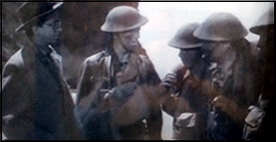
THE GORILLA MAN. Warner Bros., 1943. John Loder, Ruth Ford, Marian Hall, Richard Fraser, Lumsden Hare, Paul Cavanagh, John Abbott, Mary Field and Charles Irwin. Written by Anthony Coldeway. Directed by D. Ross Lederman.
Maybe I’m old-fashioned, but it seems to me that if you watch a movie titled The Gorilla Man, you should expect to see at least one Ape Suit in the picture. Imagine then, my disappointment to learn that the eponymous anthropoid is just the nickname hero John Loder got from fellow-soldiers in recognition of his climbing skills on a commando raid.
Well, life is full of disappointment, especially for those of us looking for cheap thrills. But in fact, Gorilla Man does offer a modicum of shivers, thanks mainly to character actor John Abbott, who plays a particularly sadistic henchman to mildly-mad doctor Paul Cavanagh.
The whole thing gets a bit over-complicated, thanks mainly to writer Coldeway’s efforts to turn a then-topical spy story into a monster movie, but here goes:
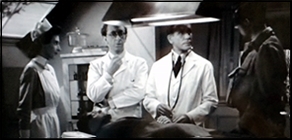
Doctor Cavanagh runs a sanitarium on the channel coast, where he gets secret orders from Berlin. You see he’s really one of those respectable-looking Nazi spies, who seem to have overrun England in wartime movies like this. Anyway, he’s warned by radio signals that Loder and his men are en route back home from a raid, and that Loder has vital information that must at all costs be kept from Army Brass. Quick as a button, henchman Abbott greets the returning raiders as they land, finds Loder slightly wounded, and spirits him off to Cavanagh’s phony hospital.
Bwa-(as they say)-ha-hah!
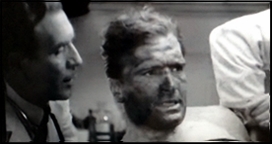
But Loder does get Germany’s secret invasion plans to the General, so Cavanagh switches to Plan B — there’s always a plan B in these things — which involves making Loder look crazy, so he won’t be believed. To this end, they release Loder and follow him around, killing helpless young ladies he comes into contact with, a task that psycho Abbott is just tickled plumb to death to carry out.
Add a dubious General into the mix, stir in a sneering Police Inspector, a jilted girlfriend who meets a grisly end, and you have an hour that moves briskly enough, served up with Warners’ usual polish. And as I say, John Abbott is really quite creepy, lurking about with google-eyed glasses and a sick grin.
But damn, where’s a Gorilla Suit when you need one!
BIOGRAPHICAL NOTE: I had a nickname in my unit too, where my comrades affectionately called me “that sorry sunuvabitch.†But I digresss….
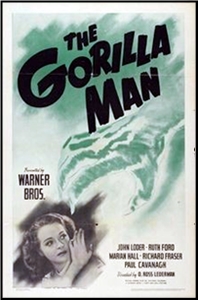
Wed 7 Apr 2021
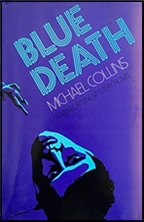
MICHAEL COLLINS – Blue Death. Dan Fortune #7. Dodd Mead, hardcover, 1975. Playboy Press, paperback, 1979.
Blue Death finds Dan Fortune a little less introspective than in his earlier cases, but with no less of a passion for the truth. Once more he is brought into a case for a simple $50 fee, and once more he finds himself with more than he bargained for. What appears a simple matter – locating the member of a giant corporation who has the power to sign a lease agreement for a parking lot – turns out to involve quadruple murder.
Along the way Fortune is beaten, drugged, and nearly starved, but he cannot be scared off the case. He suspects that a member of the corporation is blackmailing another member for murder, and his chain of reasoning is correct. All the facts fit. Unfortunately, he finds that he has been on the wrong track entirely, and before he is able to bring things to a close, the fourth murder occurs.
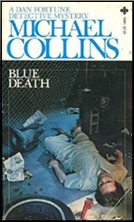
The amoral world of the large corporations comes under savage attack in Blue Death; its members appear virtually unassailable in their complacency and power, and even in the end one cannot be sure that justice will be served.
But justice is not always the point, or at least not justice under the law. Fortune is still looking for the perfect world where we are all free to run ourselves, and sometimes he gives others that chance. As in Act of Fear (reviewed here) the ending may not be entirely satisfactory, but it is appropriate. Anyone looking for the best in private-eye writing in the Chandler/Macdonald vein will appreciate any title by Michael Collins.
Other notable books in the Dan Fortune series include The Brass Rainbow (1969), Walk a Black Wind (1971), The Nightrunners (1978), and Freak (1984).
———
Reprinted with permission from 1001 Midnights, edited by Bill Pronzini & Marcia Muller and published by The Battered Silicon Dispatch Box, 2007. Copyright © 1986, 2007 by the Pronzini-Muller Family Trust.
Wed 7 Apr 2021
GARY DISHER – Consolation. Constable Paul Hirschhausen #3. Text Publishing, hardcover, November 2020. Setting: South Australia.
First Sentence: Did Hirsch own the town?
Hirsch’s territory covers a large area of not much in Tiverton, South Australia. It is up to him to keep the peace. Someone is stealing women’s underwear. Although that seems a small thing, it is the sort of thing that can escalate. And so they do, exacerbated by a woman who has developed an obsession about Hirsch.
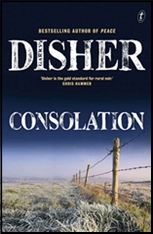
A very good introduction presents Constable Paul Hirschhausen “Hirsch” and the scope of his job, which is impressive in its scope and diversity. Issues range from the seemingly innocuous to the potentially dangerous. The jump from one incident to the next brings the residents into play. Hirsch isn’t a cop who sits behind a desk, but he spends his time walking the street, and driving the territory.
Disher is a wonderful wordsmith. One understands the words, and the meaning behind them: “Hirsch the mediator. He seemed to spend most of his time as father confessor, therapist, social worker, fixer and go-between. What he’d give for a plain old criminal and a plain old vanilla arrest.”
It is not all serious. Hirsch’s relationship with Wendy and her daughter provides normalcy, offset by his unwillingness to confront the woman who is stalking him as she becomes a threat. We see the openness of Southern Australia and the bone-chilling cold of late winter.
As the story progresses Hirsch finds one should be careful of for what one wishes when things turn violent and deadly: “…his ABC of policing said: assume nothing, believe nothing, challenge everything.”
Consolation is a story of lives intertwined; the domino effect begun by the actions of one crashing into the lives of others. This is an author well worth reading.
Rating: Very Good.
The Paul Hirschhausen series —
1. Bitter Wash Road (2013)
2. Peace (2019)
3. Consolation (2020)
Tue 6 Apr 2021
R. T. CAMPBELL – Bodies in a Bookshop. Professor John Stubbs #3. John Westhouse, Ltd., UK, hardcover, 1946. Reprinted by Dover, US, trade paperback, 1984.
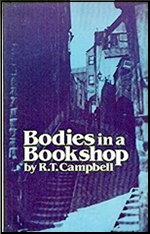
R. T. Campbell is the pseudonym of Ruthven Todd, poet, scholar, art critic, and fantasy novelist (according to the back of the book). He wrote several detective novels; I have not read any of the others, but if they are of similar quality to this one, his mystery writing would have to be marked only “fair.†His amateur detective, Professor Stubbs, and botanist Max Boyle, Stubbs’s assistant, have some similarities to Dr. Priestley and his Harold, and some to Nero Wolfe and Archie.
Max, in the course of a day’s bookhunting, finds two bodies in a gas-filled room at the back of a small bookshop. He calls in Chief Inspector Reginald Bishop, who welcomes Stubbs’ s cooperation and lets the two amateurs come along on all his interviews. This convention seems somewhat shopworn for 1946. Still, there are some lively interviews with possible suspects; some aspects of the bookseller’s business that Max had not known about are revealed, and the shady side of the book dealer’s visitor’s character is shown in all its nastiness.
Which one of them was the intended victim? Or were both intended to die? To the book lover the unexpected revelation of some very valuable old books will be a treat, even if the book itself is not in the first, or even the second, rank of mysteries.
Editorial Notes: An earlier review of this book by Doug Greene on this blog can be found here. That particular post includes a list of all seven Professor Stubbs mysteries. My own review of Unholy Dying, the first in the series, can be found here. My concluding sentence was this: “I’d have to call this one as being in the wheelhouse of those readers who already fans of the Golden Age of Detection. It won’t convert any others.”
Tue 6 Apr 2021
BREAKAWAY. RKO Radio Pictures, UK, 1956. Associated Artists Productions, US, 1957. Tom Conway (Tom ‘Duke’ Martin), Michael Balfour, Honor Blackman, Brian Worth, Bruce Seton, John Horsley, Paddy Webster. Director: Henry Cass. Available on DVD (Region 2) and currently streaming on Fandor via Amazon Prime.

In West Berlin, a German scientist named Professor Dohlman has been working on a formula which may reduce metal fatigue. He is, however, dying and gives the formula to Johnny Matlock (Brian Worth) with the instruction that it should be passed on to the young man’s brother Michael Matlock (John Horsley). Johnny is in a relationship with Michael’s secretary Diane (Paddy Webster) and meets her at the airport on his return to England.
Also entering the country is the suave, unflappable private detective Tom ‘Duke’ Martin (Tom Conway) who is welcomed by his friend, the former petty criminal Barney Wilson (Michael Balfour). Soon, Matlock and the girl are kidnapped with only Diane’s abandoned handbag remaining. ‘Duke’ investigates and learns that Diane was due to meet someone the following evening at a nightclub. He makes the appointment himself and meets the glamorous Paula (Honor Blackman), who turns out to be Diane’s sister.

Determined to return Diane’s possessions personally, ‘Duke’ discovers that everyone else wants to steal them. It seems that the formula is contained somewhere in the bag and he must find it before the bad guys kill Diane.
This routine B-film was produced by Robert S. Baker and Monty Berman, who would later have such tremendous success on television with The Saint. It is a sequel to Barbados Quest, made the same year (and reviewed here), and again stars Tom Conway in a role identical to ‘The Falcon,’ a character he played in ten B-films for RKO in the 1940s. The plot is a little more straightforward this time, albeit less interesting with its focus on corporate espionage.

Confusingly, two actors reappear from the first film in different roles, which is jarring if one sees these back to back. John Horsley’s Inspector Taylor is nowhere to be seen and the actor instead plays the sensible scientist at odds with his scheming brother, who played the bad guy last time out. There is a welcome appearance from the always excellent Alexander Gauge and a cameo from future Dad’s Army star Arthur Lowe, while real-life boxer Freddie Mills is stunt-cast as a two-fisted barman.
Both films are reasonably entertaining, but less pacey than The Falcon films and seem to have a lower budget too. They are basically a couple of pilots for a television series which never materialised, but are efficient timewasters all the same. Conway is always watchable and was born to play such suave and darkly handsome characters. More so, I believe, than his brother George Sanders, who seemed ever so slightly lecherous when in similar roles.
Conway was passed fifty here, and was beginning to show it, but proved nonetheless that he could have played the Falcon for a lot longer had RKO allowed it.
